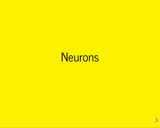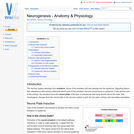
A character-driven walkthrough of the basics of neuron anatomy and physiology
- Subject:
- Anatomy/Physiology
- Life Science
- Material Type:
- Diagram/Illustration
- Lecture Notes
- Lesson
- Author:
- Luke Gliddon
- Date Added:
- 10/29/2017

A character-driven walkthrough of the basics of neuron anatomy and physiology

Nerves allow electrical impulses to propagate along their elongated cell extensions and facilitate the transfer of information throughout the body. Neural tissue is found within the central nervous system (CNS) and the peripheral nervous system (PNS) and the composition and constituent parts of neurones and their surrounding cells differ only slightly.

Gene insertion of opsin, light-activated cell-membrane channels, into neurons of interest allows researchers to manipulate light to either excite or inhibit neuronal activity to gain a better understanding of brain function and dysfunction, and explore therapeutic applications.

This patient education program discusses the symptoms, and treatment options for Parkinson's Disease, including their benefits and side effects. It also reviews the anatomy of the central nervous system. This resource is a MedlinePlus Interactive Health Tutorial from the National Library of Medicine, designed and developed by the Patient Education Institute.

This series of research talks by members of the Department of Brain and Cognitive Sciences introduces students to different approaches to the study of the brain and mind.
Topics include:
From Neurons to Neural Networks
Prefrontal Cortex and the Neural Basis of Cognitive Control
Hippocampal Memory Formation and the Role of Sleep
The Formation of Internal Modes for Learning Motor Skills
Look and See: How the Brain Selects Objects and Directs the Eyes
How the Brain Wires Itself

Students learn how neurons send and receive messages, and then build a model neuron. This activity is from the Brain Chemistry Teacher's Guide. Lessons in the guide are most appropriate for students in grades 5-10.

This resource is a video abstract of a research paper created by Research Square on behalf of its authors. It provides a synopsis that's easy to understand, and can be used to introduce the topics it covers to students, researchers, and the general public. The video's transcript is also provided in full, with a portion provided below for preview:
"Wnt signaling plays key roles in many processes, including cell polarity, proliferation, differentiation, and migration. The pathway is centrally involved in neurite and synapse development and maintenance. Wnt activity can be inhibited by Porcupine, an acylase that modifies Wnt ligands. A new study sought to understand how Wnt ligands affect neurite development. Using Wnt-C59, a Porcupine inhibitor, researchers blocked the secretion of endogenous Wnts in rat embryonic hippocampal neurons. They found that inhibiting Porcupine changed the morphology of the dendritic arbors and neurites of hippocampal neurons, while axonal polarity was not affected. β-catenin and Wnt3 levels decreased with Porcupine inhibition, while GSK-3β increased. Adding exogenous Wnt3a, 5a, and 7a ligands rescued the changes in neuronal morphology. Wnt3a restored neurite length to near the control, while Wnt7a increased the neurite length beyond that of the control..."
The rest of the transcript, along with a link to the research itself, is available on the resource itself.

This resource is a video abstract of a research paper created by Research Square on behalf of its authors. It provides a synopsis that's easy to understand, and can be used to introduce the topics it covers to students, researchers, and the general public. The video's transcript is also provided in full, with a portion provided below for preview:
"In nerve cells, the waxy molecule ceramide plays roles in both cellular differentiation and death, but a new study shows those roles could vary based on how ceramide is formed. Ceramide is generated via 3 pathways: newly from palmitoyl-CoA and serine, from the breakdown of sphingomyelin, and through the endosomal salvage pathway. Experiments showed that blocking ceramide synthesis did not alter ceramide levels in PC12 cells, which require nerve growth factor (NGF) to survive and differentiate, but blocking synthesis did decrease ceramide levels in TrkA cells, which differentiate spontaneously. Blocking sphingomyelin breakdown, however, inhibited differentiation and reduced ceramide in both cell lines. Without NGF, PC12 cells begin to atrophy and die, and preventing sphingomyelin breakdown did not protect them, but it did suppress rising ceramide levels to some degree versus controls..."
The rest of the transcript, along with a link to the research itself, is available on the resource itself.